Cowcross Street runs from just north of Smithfield Market, past Farringdon Station where the street becomes Turnmill Street and then continues up to Clerkenwell Road. All these streets have a fascinating history, however for today’s post I want to focus on a single alley, Faulkner’s Alley which can be found in Cowcross Street just before reaching Farringdon Station.
My father took the following three photos of Faulkner’s Alley in 1947:
As I work through my father’s photos I am more and more convinced that I should switch back to black and white film. The combination of getting the lighting right, and black and white is perfect for this type photography.
In the above photo there is a sign reading “M&V Coenca – First Floor”. I assume this refers to a business, but I have been unable to find any details of their trade.
I am fascinated by the placing of the chair, what I assume to be a pram and the street lamp.
Faulkner’s Alley runs between Cowcross Street and Benjamin Street, although originally it was much longer. To find the Cowcross Street entrance, walk past the entrance to Farringdon Station towards Smithfield Market and a short distance after the Castle pub is the gated entrance to Faulkner’s Alley.
The entrance looks as if it is a pedestrian entrance to the same area as the much larger entrance on the right, however there is a wall running back between the two entrances so they are completely separate entrances.
Unfortunately the gate was locked during my visit, so all I could get was a view through the gate showing a similar alley to that in my father’s photos.
The following extract from the 1895 Ordnance Survey map shows Faulkner’s Alley in the centre of the map, between Cowcross Street and Benjamin Street. If you follow across Benjamin Street, there is a continuation of an alley indicating that Faulkner’s Alley probably once extended much further.
As the entrance in Cowcross Street was locked I walked round to Benjamin Street to see if the entrance there was open, as in the past it has always been possible to walk through the alley.
However I was rather shocked by what I found. The southern side of Benjamin Street is now a building site.
Which extends a considerable distance along the street. Just here on the right is where the entrance to Faulkner’s Alley was once located.
It was a similar gated entrance to the one in Cowcross Street, with the same style of ironwork and name above the gate.
I had a look at the planning applications on the Islington Council web site and found the application relating to the building work in Benjamin Street.
The application covers the demolition of the existing buildings and the build of a 6 storey building on Turnmill Street and 5 storey building on Benjamin Street, with both buildings being linked by a 4 storey building. The new building will comprise retail, office and 4 residential units.
The plans show Faulkner’s Alley will still run from Cowcross Street to Benjamin Street and there will be a gate onto Benjamin Street as part of the new build. Along the alley will be a courtyard and residential reception. I wonder with the new development whether Faulkner’s Alley will continue to accessible to the public or with the new residential and office build, it will only be accessible to those living or working in the buildings.
The site is owned by the Girdlers’ Company (one of the City’s livery companies) so hopefully Faulkner’s Alley will have a restoration that recognises its history and as a public alley, although I do worry when I read on the architects’ web site that the alley will be “enhanced” as part of the project.
Along the wooden hoarding, there is a small display of excavation findings which include some Tudor brick, medieval tiles and clay pipes:
We can get an impression of Faulkner’s Alley in previous centuries from newspaper reports. Some examples:
From the London City Press on the 9th April 1864 in an article on overcrowding in the city:
“I may mention that I found one family with but two moderate sized rooms, in Faulkner’s Alley, had taken in six railway navvies as lodgers. Even if they spend little more time in-doors than what they require for sleep, that is time enough to breed a fever, as was the case in this instance, for one of the lodgers had been prostrated by typhus fever, and sent by the Union authorities to the Fever Hospital.”
From the Islington Gazette on the 9th July 1877:
“A SINGULAR CASE – Dr. Hardwicke held an inquest at the St. Andrew’s Board Room, Great James-street, Holborn, on Friday, concerning the death of a newly-born male child, which was found on a doorstep in Faulkner’s-alley, Clerkenwell, and for which a woman of the name of Mohan is under remand, charged on suspicion with having deposited the child. The facts in connection with this case were reported in the proceedings at the Clerkenwell Police-court, and it will be remembered that on Tuesday night, about 10 o’clock, a constable stated that he saw the woman in question go into Faulkner’s-alley and stoop down, but whether she placed anything on a doorstep he could not say. Upon going up the alley a short time afterwards, however, a brown-paper parcel containing the body of a child much decomposed was found. The woman Mohan denied that she knew anything about the child, and the jury returned a verdict that the child was found dead in a state of decomposition, and that the evidence was insufficient to show the cause of death. They also added that they were of the opinion that the police were in error in charging Sarah Mohan.”
The London City Press on the 5th September 1863 included an article titled “Old Smithfield and its Precincts – A Sanitary and Antiquarian Ramble” where the author took a walk around the area and described what he saw, including this description of Faulkner’s Alley:
“Passing up Cowcross-street to Smithfield-bars, there are some quaint houses and shops. Part of the frounts in Faulkner’s-alley are of wood, and are worth notice. And here, as well as in some other confined places where the people are very poor, there are, considering the situations, wonderful displays of window plants and flowers. We would, however, just hint that in some instances the windows are so crowded with drooping and other greenery, that it interferes to a great extent with the proper admission of light and with ventilation.”
A report in the Pall Mall Gazette on the 4th September 1878 on the Princess Alice disaster, when the steamboat the Princess Alice was rammed by the collier Bywell Castle near Woolwich, included a list of the survivors, one of which was Mary Brent of Faulkner’s Alley. There was no accurate record of the number on board the steamer, or the number that died, however the Pall Mall Gazette reported that between 700 and 800 people were on board, and the number dead or missing was in the order of 700 – so Mary Brent was one of the few, very lucky, survivors.
The book “London – Alleys, Byways and Courts” by Alan Stapleton, published in 1924, also includes a brief description of Faulkner’s Alley:
“A few yards past here on the left, by No. 31, is the alley with the wooden frontage, with its name, Faulkner’s Alley, at the top. This old wooden front dates from about 1660 when the alley was formed, and built in.”
The book also includes the following drawing of the entrance to Faulkner’s Alley from Cow Cross Street:
We can trace the development of the alley over the centuries. In 1746 Faulkner’s Alley was shown in John Rocque’s map:
In Rocque’s map, the alley extended across Benjamin Street into what is now the edge of St. John’s Gardens. The map also provides a clue to the origin of the name.
In 1746 Rocque labelled the alley Faulconers Alley which may possibly have some reference to the Falcon bird, as Faulcon was an early spelling for the bird, a name with French origins, and the word Faulconer was given to the person who would look after the birds. I have not been able to find any written reference as to why this name should have been used for the alley.
Going back further, Ogilby’s map of 1676 shows the alley as a much longer alley. Unfortunately Ogilby does not provide the name of the alley as it would be interesting to see if the name was the same as in 1746.
Faulkner’s Alley was a good example of the type of alley that was once so common across the city. My father’s photos from 1947 show the alley much as it must have been during the 19th century and possibly earlier – a narrow alley with tall, brick-built buildings lining the alley occupied by people and businesses.
I hope that when the building on Benjamin Street is complete, Faulkner’s Alley is open again and that whatever “enhancement” has been made during building work, Faulkner’s Alley retains much of its original character.

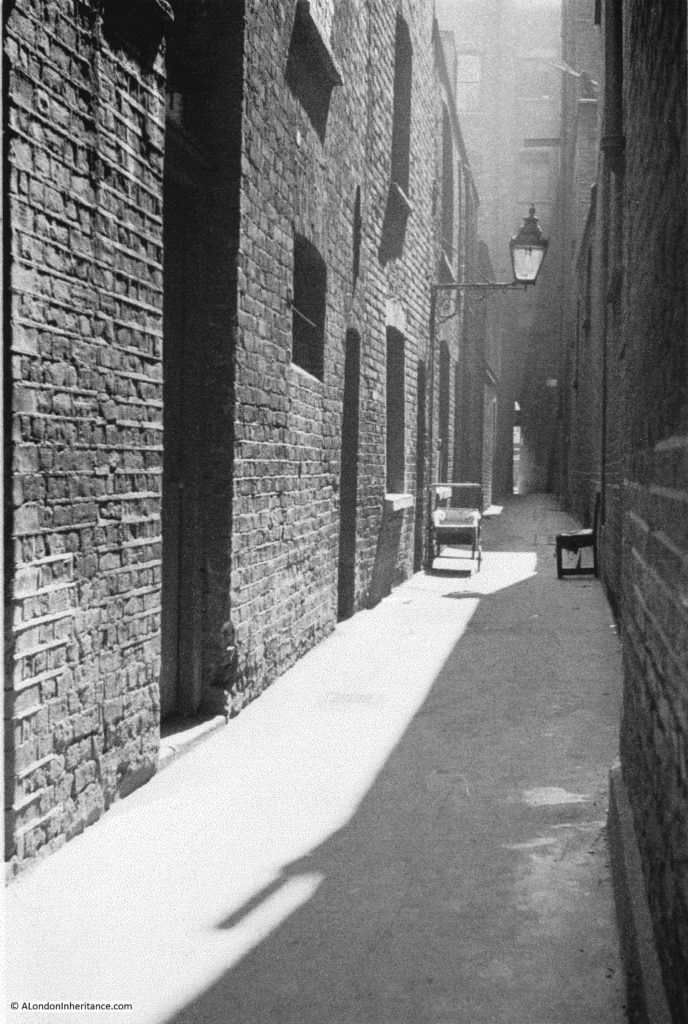

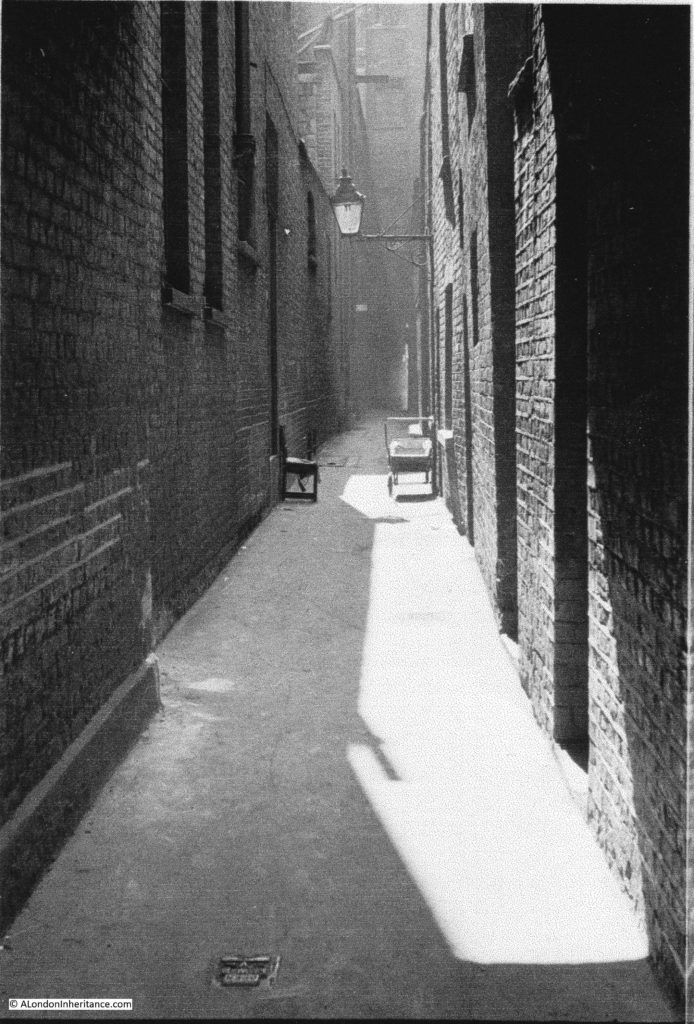
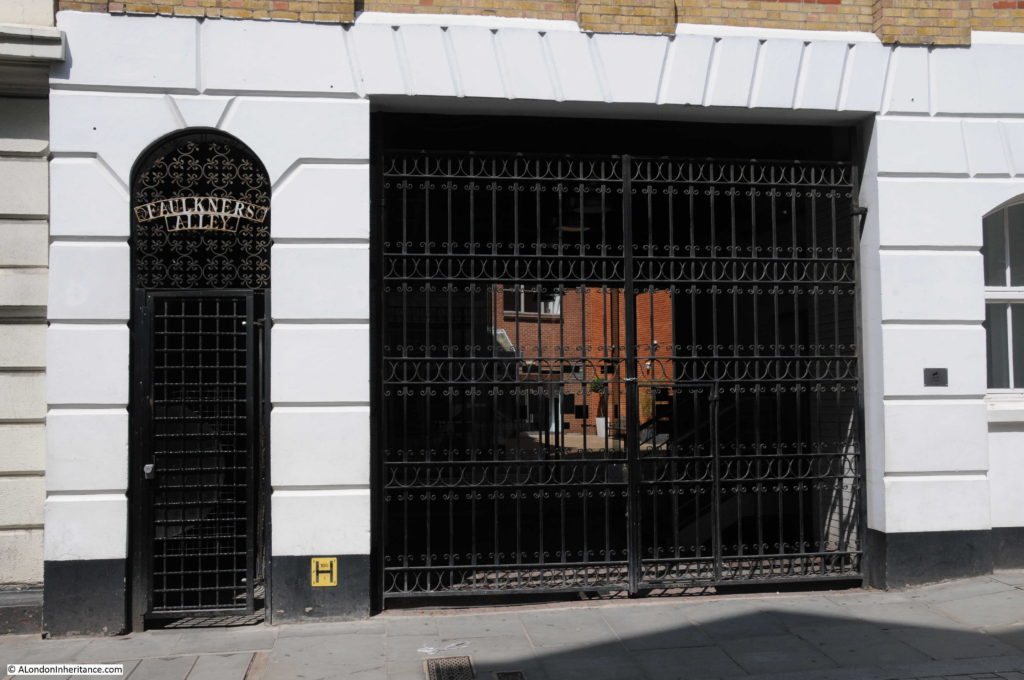
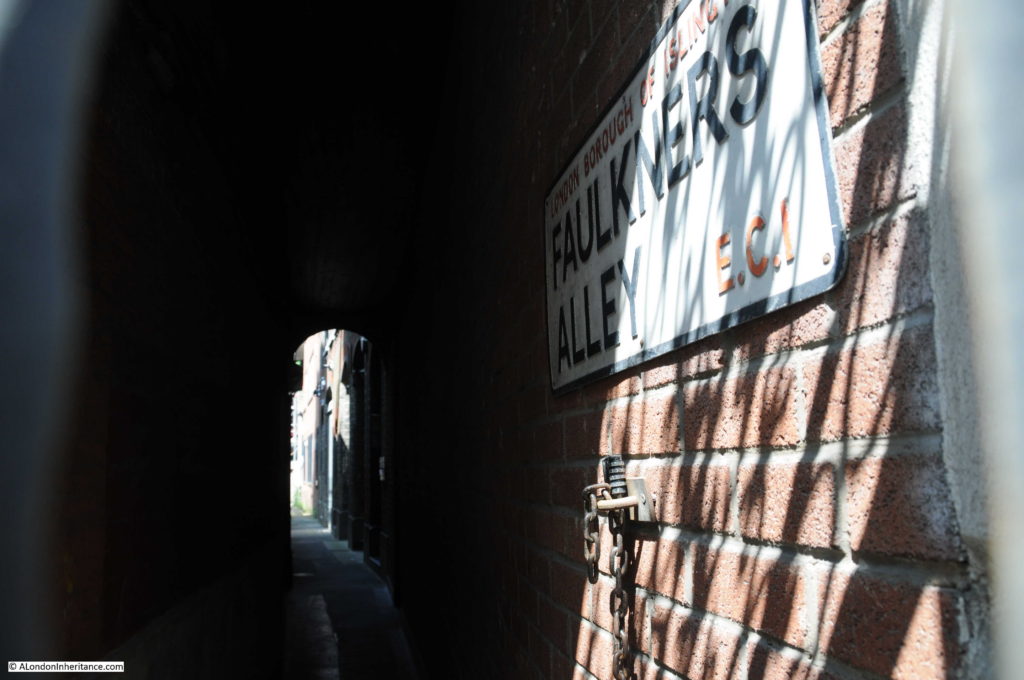
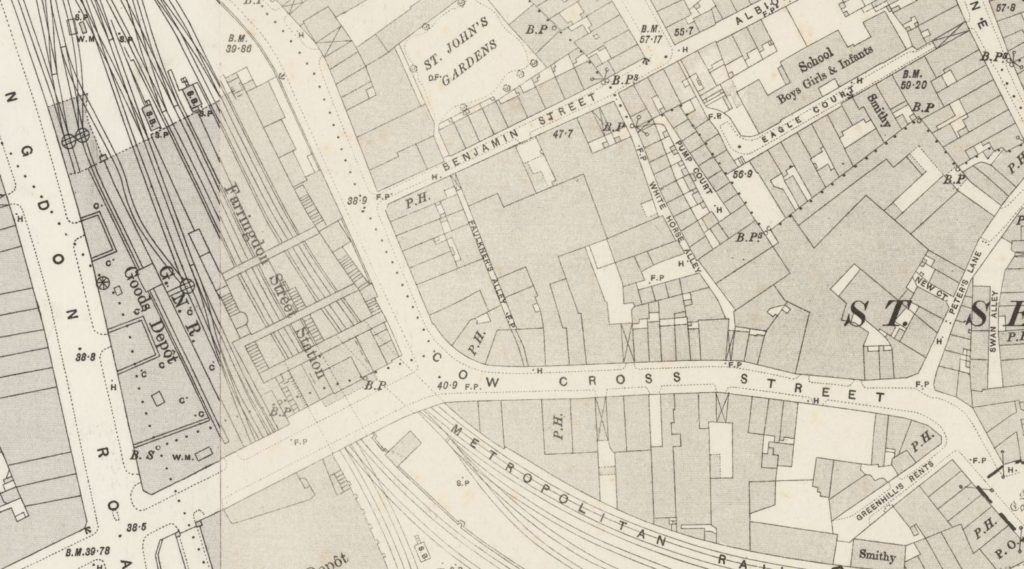


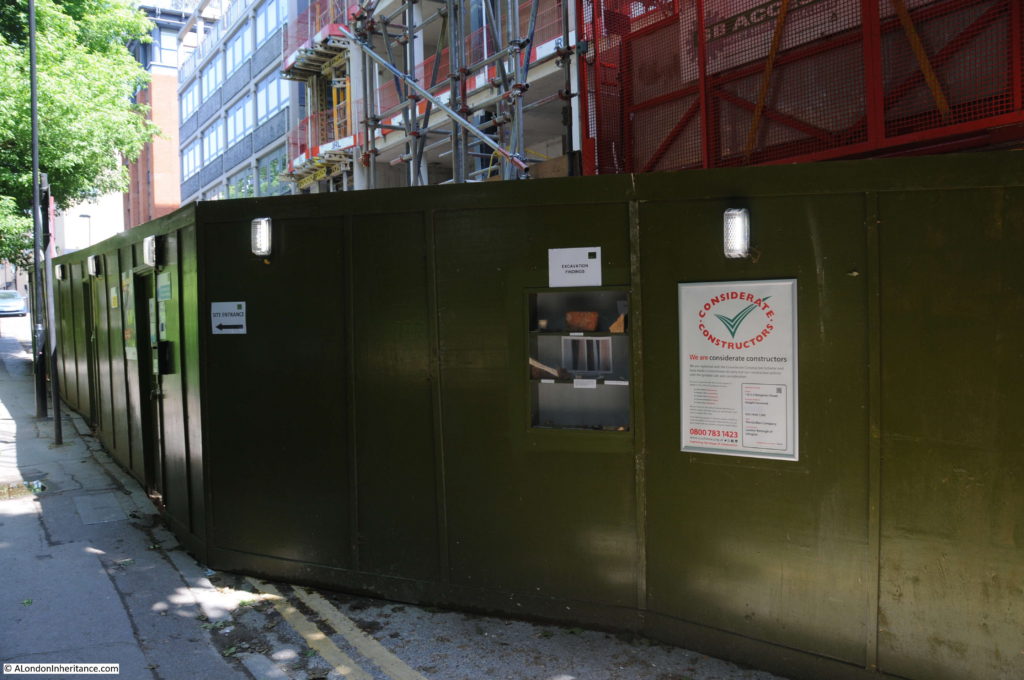
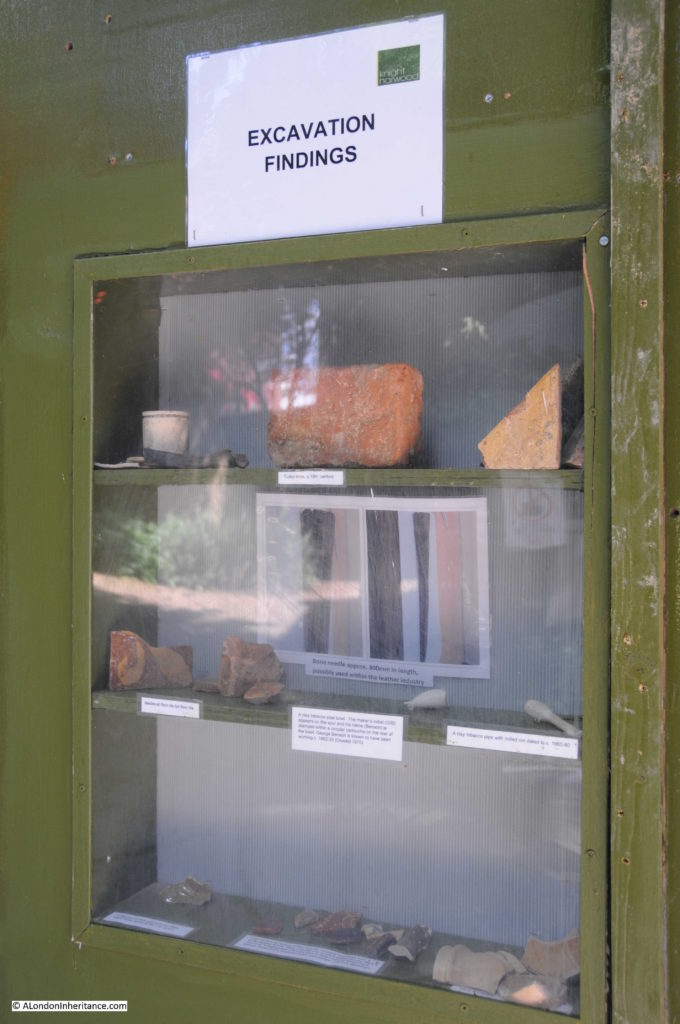
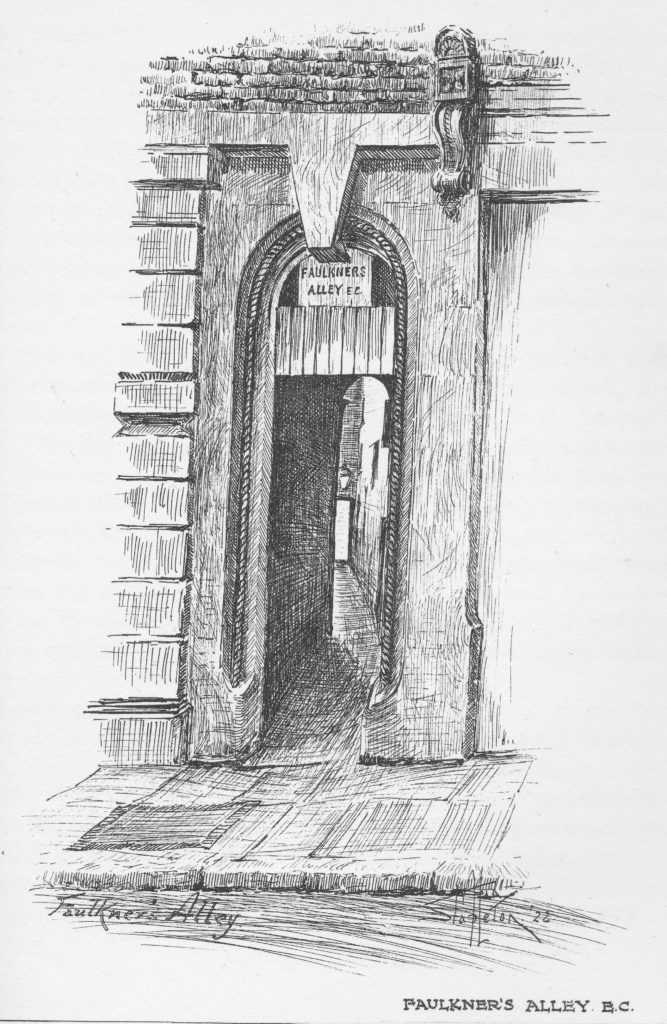
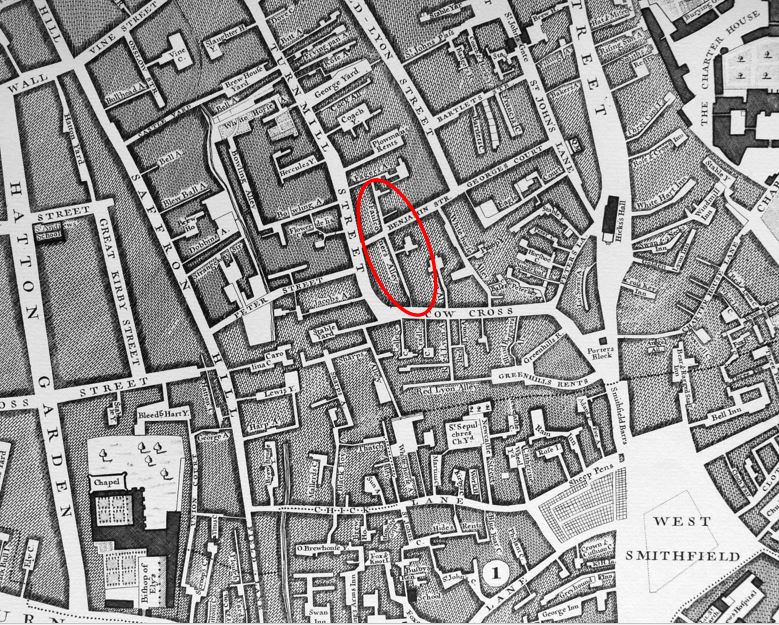

Shame it’s closed to the public.
I love your posts… I look forward to your email every Sunday afternoon here in South Australia.
Thanks Mick, really good to know that I have a reader in South Australia.
Very interesting post and I wondered whether this was where Faulkner’s Tobacco company was located, pre WW11? My parents worked there before it moved to Ogdens in Liverpool.
I hope that someone will check the details of the planning application ……..
Another superb article, many thanks for your hard work.
My Post Office London Directory 1948 ed tells me that at 3 & 4 Faulkners Alley, Cowcross Street were Coenca M & V. Tobacco pipe makers. Tel CLErkenwell 5916.
Hi, just seen in the England and Wales Register 1939 (on the Ancestry website) a M. Coenca living in Hammersmith described as a “smoking pipe manufacturer”.
Thanks for this one – I’m down that way once a week and will take a look next time. Your father’s b/e pics are so atmospheric.
love your posts,
for generations my family was born and bred in and around this area.
from my understanding there was mainly an immigrant population living in and around Faulkners alley.
businesses mainly around the area where cabinet makers.
always known as a rough area, people would start there when first arriving in the city and then move on to better places.
Do you know if this was where Faulkner’s tobacco company was located? My parents worked there pre war before the company moved to Liverpool.
Another facinating insight into London’s rich (and poor) past. I stayed at the Rookery hotel recently and was amazed at the wholesale transformation of the area lagely brought about by the inception of Crossrail. I suppose the hotel took it’s name from the infamous slums of London’s yesteryear although the hotel is rather more famous as the place where Peter Doherty was arrested in a drugs bust!
When I was a printers apprentice in the late sixties our college was at the old Daily Mirror building in Back Hill off Clerkenwell Road and I would buy old books from the book stalls in Farringdon Road opposite Safron Street in my lunch break – I still have a very early copy of Spencer’s Fairy Queen that I bought there.
I intend to revisit the area soon to further explore the well of Clerkenwell and some of the area’s pubs and artisan buildings before they are reinvented.
Thank you for a wonderful series, I have missed some of them and wonder how you rediscovered your father’s photos and how long you have been researching them?
My Grandmother was born and lived in Fleur De Lis Court 1860 behind Cow Cross St and Peter Lane. When I visited in the late 90s it was being built on, just like this. I’m wondering if your father took any photos of this area in 1947? I’ve never found any photos at all.
regards
Hi Joy,
Noticed your comment and found this online. No photos but it might be of interest. Hope you find photos one day. http://www.british-history.ac.uk/survey-london/vol46/pp182-202
Annie
wow – thank you so much Ann – lots to read! My Great Grandparents lived at what is now the Rookery Hotel – corner of Cowcross St/ Peter Lane
My mum lived at 15 Benjamin street. I wonder if they knew each other.
My great grand mother Mary pilgrim was born and grew up at 54 cow cross st I wonder if there knew each other
I just want to say thank you for your fascinating posts and the amount of detail you include. I love London and its history, but unfortunately live 4000 miles away and don’t get there as much as I would like.
I’ve nipped down the alley several times over the years. However, it was often gated off at the Benjamin Street end so I’m not sure it was an entirely public right of way.
When I have walked through in the past it has been open on weekdays, so not sure if it was just closed at weekends. The Benjamin Street end is completely blocked by the building work and the Cowcross Street entrance looked as if it had not been open for a while. Good point about public right of way. In the 1947 photos you can also see a gate so it must have been a gated alley for many years, so perhaps not a public right of way.
Fascinating stuff, as always. Bit about Coenca here http://console.snapadministration.com/common/file_provider.aspx?id=634230223084032500
“On the 16th August, 1933 a monopoly was granted to Messrs. Maurice and Victor Coenca of 3, 4, Faulkner’s Alley, Cowcross Street, London to manufacture pipes, pipe parts and related accessories in Malta for a period of 10 years, which monopoly was transferred in 1935 to Archibald William Stone, Esq. of 10/12, Pentonville Road, London.”
Hello (I’ve been reading -enthralled- your reports of an area I work in and know well)
But:
I’d be very interested to read the full piece from the London City Press
(5th September 1863) “Old Smithfield and its Precincts – A Sanitary and Antiquarian Ramble”
Could you provide a link/reference ?
Thanks – Alistair
Very interesting read as usual, re Coenca pipes amazing how big this industry used to be as recently passed John Redmans British Empire Pipe manufacturer just off City Road…….
I spent a happy couple of hours some months ago looking this up on google maps and collage. Another alleyway to explore in a few months, I think. Such a sad place to put a dead child.
Fascinating entry. I appreciate all the research and your measured tones in reporting the facts however upsetting or discouraging the findings are sometimes. I loved the newspaper article which mentioned the poor people with all the plants in the windows preventing good circulation of air!! Really enjoying your blog. Thank you.
Could the lawyers amongst us clarify the legal basis whereby Islington Council and the property developers in the article can limit or close Faulkners Alley to the general public. It seems to me that there is an important legal issue here. In a previous article about Cardinal Cap Alley in south London a iron gate was shown at the entrance to the historic alley. Is the public now prohibited from walking down the alley? From who do they have to get permission?
Could developers with the permission of a local council prohibit the general public from larger streets, say for instance, Oxford Street or Upper Thames Street in the City because of a big property development?
Brilliant a ever.
though it always drives me made that those letter ‘A’s on the gate are flipped!!!
A most interesting article like all the others which I have read. A real insight into the past – a real piece of research.
Can pass that way if I choose a more circuitous route home. Earlier this week I passed at around 6pm and found the CowCross gate open. The other end is blocked by the building work and may become open again when it is safe.
I was able to photograph the alley and I can send it to you if interested.
Interesting reading. I own a business that operates out of 1-2 Faulkners Alley. The gate from Cowcross Street is open during business hours Mon – Friday. The gate is locked in the evenings and weekends. We often get all sorts of horrid people using the Alley Way as toilet so I’m not surprised the gate is shut at night as there are still people living in the residential building here. The entrance in Benjamin Street will still be open to the public one the new build is done – or it my understanding from meetings with the developers that it will be, the building is going over the alley leaving an arch, exactly as it was prior to the new build.
Thanks for the information Sally, and understand the challenges with the alley and the reason for keeping it locked during the evenings and weekends. Good to know that the entrance to the alley will be much the same when the new build is completed.
Just to let you know that Faulkners Alley is now open again and you can now get in and out of both ends…
Thank you for publishing the post and the photos! They were fantastic to see for me as the business M & V Coenca belonged to my grandfather and his brother: Vidal and Maurice Coenca, who were manufacturers of pipes and cigarette holders. The were Spanish Jews from the Ottoman Empire who emigrated to London 1911/1912. The office, consisting of two floors in the building, was bought in 1921 and remained there until 1960. I never met my grandfather unfortunately, as was born after hi had passed away but I’m currently doing research on his life (I’m a writer).
I would love to have paper copies of your fathers photographs, if possible (and would of course pay for any costs). Thank you, once again. /Elisabeth
Thanks again for another intriguing post. I have often wondered about that alley myself when I stop to roll my eyes at the flipped letter ‘A’s within the name on the ironwork gate!
Hello. Very interesting to read your post which my cousin forwarded to me. My dad is 83 now and was born in Faulkner’s Alley. The youngest of nine children. The family were Londoners from the Clerkenwell area and eventually moved after the war to a house in Liverpool Road Islington. We took him back there in 2016 on a trip down memory lane and we able to walk through the alley, which was undergoing building works. The ironwork gate with then name means a lot to us!!
He remembers Clerkenwell being ablaze during the blitz and had many memories. We hope it remains there for many more years to come.
Well said Lisa! Faulkner’s Alley is a family heirloom to us
I’m one of those crazy people researching their family tree….. My 7th Great Grandfather – Isaac Bayley/Bailey (c1723 : 1804) died in Faulkner’s Alley. This was the address provided on his burial records.
Love the photo’s. Always a treasure to find pictures of where my ancestors once lived.
I did my printing compositors apprenticeship with a firm called Byron Davies Ltd who were a new business partnership of Roger Davies and John Hockley. I was their first employee in 1955 in a building in Faulkner’s Alley off Cowcross Street, London EC1. My first job was to help them bale out a foot of stagnant water from the basement so that it could be used for printing machinery. The company folded in five years and I was found a position for my final year in another alley behind Guys Hospital near London Bridge. Very interesting in your bringing back my old memories but can’t remember name of the alley off Borough High Street near Guys Hospital. Will come to me later as there was pub opposite our front door. Printer was A. O. Fallek, a Frenchman. Not on Facebook or Twitter.
My great grandparents and family are shown in the 1911 census as living at 13 Faulner’s Alley
My grandfather was born at 1 Fulkners ally. In the 1890s. After ww1 he came to New Zealand and never returned.